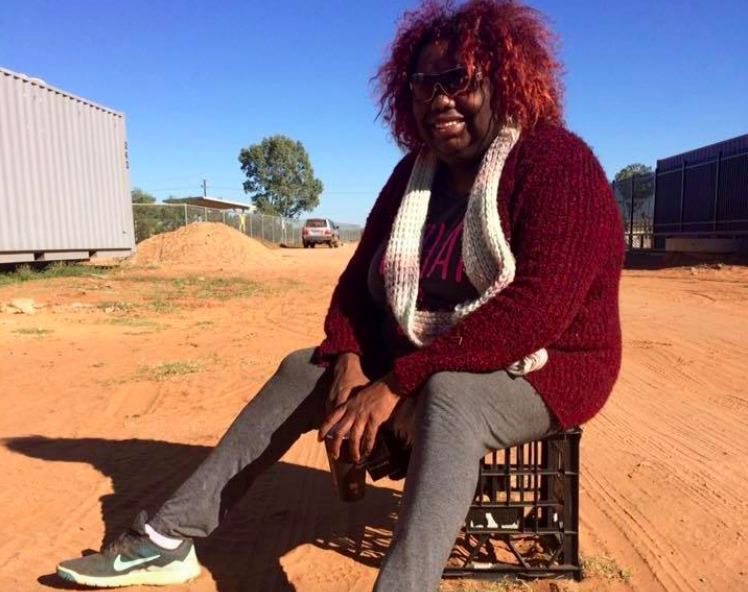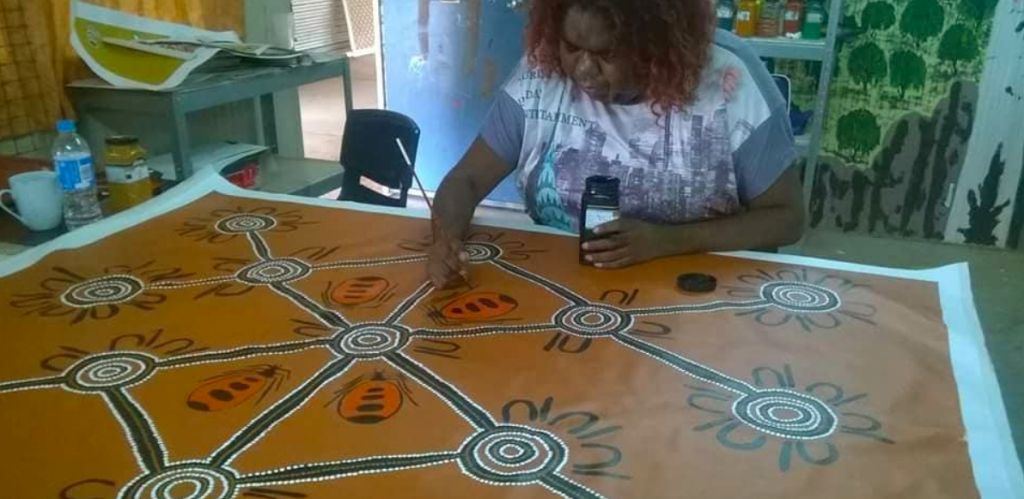While Indigenous people in Australia have fared better than others in the time of COVID-19, Farid Farid looks at how Indigenous Australians have dealt with the pandemic.
Que Nakamarra Kenny, an Arranta visual artist and activist, would like to travel again once the coronavirus crisis eases.
Before the lockdown in her remote Northern Territory hometown of Ntaria – also known as Hermannsburg – about 125km west of Alice Springs, Kenny went on a European tour for a documentary she had participated in about the pernicious practices by mining companies that have ravaged, as much as benefited, Aboriginal communities in recent years.
“The trip was amazing and whenever everything gets back to normal in international travel I would still love to travel parts of the world,” she tells Rolling Stone Australia.

“Being in remote communities is being like the last people to ever know what is actually happening,” explains Arranta artist Que Kenny. (Photo courtesy of Que Kenny)
But for now her attention in self-isolation has turned to supporting elders in her ageing community. “It makes me a frontline worker,” she quips, but bubbling beneath is a frustration that the national lockdown has made remote towns feel a greater sense of distance, fully living up to the sense of remoteness more than ever before.
“It’s so degrading not having access to buy any underwear and body hygiene products.”
“The COVID-19 rules and restrictions have made us feel so annoyed. […] We are not able to travel into major towns such as Alice Springs to do grocery shopping for much healthier food, including clothes shopping.
“I mean, it’s so degrading not having access to buy any underwear and body hygiene products.”
Love Music?
Get your daily dose of everything happening in Australian/New Zealand music and globally.
Matters of Life and Death
Indigenous people in Australia have fared better than most since the global pandemic started, even though they are at more risk of contracting the disease. Aboriginal and Torres Strait Islander people are disproportionately over-represented in chronic diseases such as respiratory and heart conditions.
Indigenous people have a lower life expectancy than the rest of the Australian population (dying ten years earlier on average than non-Indigenous Australians), are three times the national average for diabetes prevalence, and have high infant mortality rates.
These stark life and death matters are not by accident, but are a consistent result of the long history of colonisation and repeated failure of policies such as incarceration and entrenching economic disadvantage that have contributed to such a health gap.
The contagious COVID-19 disease has claimed over 345,000 deaths worldwide including more than 100 in Australia thus far.
Mercifully, Indigenous people in Australia have been spared deaths and infections, in comparison with other indigenous groups such as the Navajo Nation in the United States and the nearly one million Amazon-inhabiting indigenous people in Brazil.
It is an early sign that the response has been effective so far according to Professor James Ward, Director of University of Queensland’s Poche Centre for Indigenous Health.
“So far Aboriginal and Torres Strait Islander people in Australia have largely avoided the virus, despite having some of the largest risk factors for an outbreak to occur,” he tells Rolling Stone.
He noted that only 60 cases among Aboriginal and Torres Strait Islander people have been reported, representing less than 1% of the country’s overall tally.
Ward, a Pitjantjatjara and Narungga man, puts that down to a rigorous, national action plan that was implemented early on to protect Indigenous communities who are most at risk.
“So far Aboriginal and Torres Strait Islander people in Australia have largely avoided the virus, despite having some of the largest risk factors for an outbreak to occur.”
“What else can be attributed to this success is early action, leadership, mobilisation of communities and responses, lock down of communities and travel, and a lot of preparedness planning for the worst possible scenarios in communities spanning remote areas to urban areas,” he says.
Around 80% of Indigenous people live in urban areas and they face their own unique challenges such as overcrowding even if they live in major centres.
“Very few cases have been transmitted locally and no cases have occurred in a remote community where just over 20% of our population live,” Ward notes.
He is quick to caution that with authorities easing restrictions, Indigenous communities need to remain vigilant.
“While this success is early we have still a long way to go and over the next few months as Australia approaches winter and the relaxation of national travel continues we will be watching this space very closely like hawks hovering above,” he adds.
“Living in A Rough Terrain”
In Hermannsburg, Que Kenny says the community has been taking the pandemic in its stride. Frustration with isolation remains a constant presence punctuating long days of trying to stay alive amid several power cuts.
Kenny outlined how the small town’s community was taken by surprise as the health crisis led to the enforcement of lockdown in mid-March.
“Due to not having more of a time frame for which our shops can prepare for such a pandemic […] we ran out of hand sanitiser and soap because in this time of a health crisis everyone rushed for the items,” she says.
“Most food is not fresh and healthy and our meat supplies are frozen so not always fresh as when you go to a Coles shopping centre.”

“Living in remote communities is so different to what you have in Sydney or Brisbane – the lifestyle isn’t at the same level,” Que Kenny explains. (Photo courtesy of Que Kenny)
Some communities have complained about the lack of personal protective equipment being available and holding back rapid testing while others have worried they might be infected from outsiders.
“Living in remote communities is so different to what you have in Sydney or Brisbane – the lifestyle isn’t at the same level. We live in a rough terrain and even our local non-Indigenous workers are frustrated. […] The local clinic has masks but it is up to them on however they want to use them,” Kenny intimated.
“Being in remote communities is being like the last people to ever know what is actually happening.”
Ward says that mobile testing will ultimately reach around 87 remote indigenous communities nationwide and that local organisations have taken the lead in shielding their elders, who are most at risk of dying from the disease. But more is to be done beyond health concerns that the pandemic has highlighted.
For Kenny as she hunkers down, she is exercising a bit more and also working on her elaborate paintings from time to time. She said people in Hermannsburg are not panicking, they’re going about their business, but there still is “a lot of confusion” about the necessary medical information to follow as the virus becomes a lived, daily reality to reckon with.
“Being in remote communities is being like the last people to ever know what is actually happening,” Que quips.



































